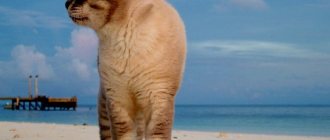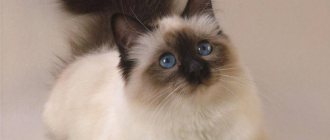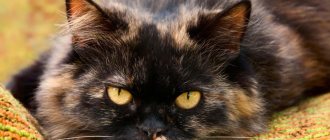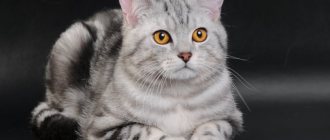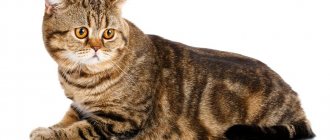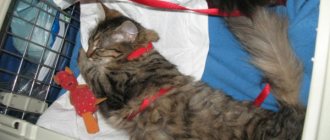Pets, and not only them, often get sick, and many of their diseases are similar to human ones. But a cat, unlike a person, during an illness cannot talk about its well-being or what is bothering it.
In this regard, the greatest responsibility lies with you, the owner, because you yourself must notice the cat’s dry nose, changes in activity, temperature or other problems.
Today we will talk specifically about dry nose in cats, the causes of this symptom, possible diseases and much more.
Causes of dry nose
First of all, you shouldn't worry about this right away. There are many more reasons why a cat has a dry nose than you might imagine, and not all of them are hazardous to health or simply problematic.
First, let's talk about the simplest and most ordinary situations that can occur every day, or even several times a day.
We are now talking about the simple time after sleep. The fact is that after sleep, cats' noses will always be a little dry and this is quite normal. In this case, the reasons for a cat’s dry nose lie in the fact that during sleep he simply does not lick it, which is why this happens.
The same story will happen with excessive activity, especially if it all happened in the fresh air and under the sun.
Read here Pancreatitis in cats: first symptoms, nutritional nuances and treatment options (125 photos and videos)
In this case, both the environment and the cat’s own body temperature play an important role, which becomes noticeably higher during physical activity. We are not yet talking about additional factors, such as dust, strong wind, and so on.
The most interesting thing is that similar things can happen under normal conditions at home, especially in winter, when the cat lies for a long time near or even on the heating radiator.
It is not uncommon for cats to have a dry nose at fairly low temperatures. This happens because a cat instinctively stops licking its nose when the environment becomes too cold.
In this case, you should not think about whether the cat should have a dry or wet nose - it is better to wait until he gets into a more normal environment for an extended period of time.
Cat fingerprinting
You've probably noticed that cats' noses are rough. But every cat has its own unique pattern on its nose. This uniqueness is akin to human fingerprints. Just as you can't find two people with the same prints, you can't find two cats with the same nose pattern. This feature can be used to recognize animals.
The color of the nose depends on the color of the cat as a whole. Some cat breeds are distinguished by the fact that their noses have a dark edging. For example, the chinchilla breed can boast of such natural “eyeliner”.
Should your nose be wet?
You forget that the cat is first and foremost a predator by nature. During the hunt, he needs to be able to determine the direction of the wind in order to sneak up on the prey unnoticed - in this regard, they are incredibly similar to relatives like a tiger or a cheetah, and for this they use their nose, which must be wet.
This is why you should understand what to do if your cat has a dry nose. In addition, a cat's nose also has more mundane tasks, such as simply determining the temperature of objects by approaching them.
That is why, if for various reasons a cat’s nose is dry for a long time, it may begin to crack, and this promises not only simple discomfort, but also a disruption of the animal’s normal life.
Smell is everything to a cat
It all starts from the very first days of life. After all, newborn kittens are completely blind. How then do they unmistakably find the mother cat’s milk nipples? Of course, by smell. By smell, the mother cat herself distinguishes kittens from the same litter, and the kittens themselves distinguish each other and all surrounding objects.
Cats mark their territory using special odorous liquids that are secreted by glands on their faces and near their tails. This is why cats often rub their faces against objects. Including the owners, they also mark them as something that is located on their territory and is their property.
Cats find a cat that is ready to mate by smell, and cats find the cat that is most suitable for them. The smell also identifies whose territory the cat is currently in, or whether a stranger is present in his own possessions.
Parting with familiar smells causes quite a lot of stress in a cat. That’s why your pets have such a hard time going through moving, buying new furniture, and especially renovations. After all, if when moving or buying a new sofa the smells remain more or less natural, then during renovation the smells of paints and other building materials can simply drive the poor animal crazy. Therefore, during the period of reconstruction, it is better to take the cat to the dacha or to another house.
It should be noted that the shape of cat noses depends on the breed. It is clear that the nose of a Siamese or Siberian cat will be much larger than the nose of a Persian. And the hump nose of a Burmese cat can be safely described as aristocratic or “Roman”.
Action plan
If you find a dry nose in your cat, then the first thing you need to do is be patient and watch it for a day or two.
In this case, you will have the most complete picture possible, both about his behavior and regarding other possible symptoms.
If even with a dry nose, the cat’s general behavior does not change - he is very active, sleeps enough, eats well, then most likely you can dispel your worries about this.
But you must understand that even in a situation where you find a dry nose, which has begun to crack, you should not try to smear it with anything.
Getting rid of the causes of such a problem will in itself begin to return everything to normal - the cracks will heal, and the cat will lick its nose and restore the required level of humidity.
Ringworm in cats - main signs, symptoms, prevention and treatment of ringworm in cats (105 photos)- Pancreatitis in cats: first symptoms, nutritional nuances and treatment options (125 photos and videos)
- Subcutaneous mites in cats - first symptoms, treatment options and real photos of examples of parasite damage (110 photos + video)
Cat breeds with a flattened face and large eyes
Brachycephaly is a shortened longitudinal diameter of the skull. These cats have a spherical head shape.
There are not many brachycephalic cats registered in felinological organizations. They all have a similar skull structure, but differ from each other in body type, coat length and character.
The most popular among existing breeds of cats with a flattened face are:
- Persian cat;
- exotic;
- Himalayan cat;
- British Shorthair;
- Scottish fold cats;
- wild cat manul.
Persian cat
These fluffy animals with a flattened nose appeared several centuries ago and have not lost popularity since then. They are quite large in size - some individuals can weigh up to 7 kg.
Purebred Persians are easily recognized by their squat body with short legs and unusual flat muzzle with large, expressive eyes. The compact body of snub-nosed cats is covered with luxurious fur, the length of which can reach 12 cm.
Depending on the structure of the skull, the following types are distinguished in the breed:
- classic - with the nose located below eye level;
- modern - with a lobe located in line with the lower eyelid;
- extreme - with a concave nose located level with the inner corners of the eyes.
In addition to its attractive appearance, this cat with a flattened muzzle and large eyes is endowed with a balanced, gentle disposition. True, sometimes the truly royal calm of representatives of the breed can give way to demands and whims.
The snub-nosed Persian prefers to spend most of his time on a soft sofa. So owners of these luxurious, flat-faced cats won't have to worry about tattered curtains or scratched furniture.
Exotic
This flat-faced cat is closely related to Persians and American Shorthairs. It was developed in the United States in the 1960s and quickly achieved breed status. The plush cats with a flattened face were originally called Sterlings, but were later renamed Exotic Shorthairs.
Snub-nosed cats are relatively large in size and weigh up to 7 kg. The distinctive hallmark of the breed is its small, forward-pointing ears, pronounced cheeks and huge, wide-set eyes.
Compact, tightly knit exotics are covered with short, silky, two-layer coat of almost any color.
Squat cats with a flattened muzzle and large eyes are distinguished by a calm and peaceful disposition. Playful and friendly representatives of the breed never show aggression or make unnecessary noise. Snub-nosed cats quickly become attached to their owners and get along with other pets without problems.
Himalayan cat
These owners of a flattened muzzle and large eyes were the result of crossing representatives of the Persian and Siamese breeds. To date, Himalayan cats are not recognized by all felinological organizations. In some associations, kittens of this breed are registered as Persian.
From both ancestors, Himalayan cats took only the best features:
- from the Persians they inherited a flattened nose and luxurious long hair;
- from the Siamese they got blue eyes and a beautiful color-point color.
Snub-nosed Himalayan cats are endowed not only with an interesting appearance, but also with a wonderful character. Representatives of the breed are distinguished by a calm, affectionate and slightly lazy disposition. These fluffy cats with large eyes and a flattened muzzle get along well with children and are patient with all their pranks.
British Shorthair
The name of this popular and widespread breed is known even to those who are far from the world of felinology. The British Shorthair is easily recognized by its rounded, flattened muzzle, large expressive eyes and squat body covered with plush fur of different colors.
These attractive snub-nosed cats are endowed with a balanced and flexible disposition. Neat and intelligent representatives of the breed tolerate loneliness well and lend themselves well to education.
Short-haired cats with large eyes and a flattened muzzle have simply limitless patience and rarely release their claws.
Scottish fold cats
Representatives of this breed are endowed with an unusual appearance. Their main distinguishing feature is their ears that are tilted forward and downward. The closer their tips are in contact with the surface of the head, the more valuable the animal is considered.
The snub-nosed Scottish cat has a moderately flattened muzzle and a powerful body covered with thick, soft hair of different colors.
On a note. The straight-eared Scotsman is called the Scottish Straight. It is used in breeding along with lop-eared representatives of the breed to reduce the risk of sick offspring.
Unpretentious Scots are endowed with a balanced and calm disposition. Representatives of the breed are distinguished by their playful character and high intelligence. These peaceful cats with a flattened muzzle, curled ears and large eyes get along well with children and do not like to be left alone.
Wild cat manul
These representatives of the cat family live in Central Asia. They are considered rare and are included in the Red Book.
The large body of the Pallas cat is covered with thick striped fur. And the flattened shape of the muzzle allows you to breathe through the mouth without weakening the grip of the jaws and without releasing prey from the teeth.
Photo of a cat's nose
Help the site, share with friends 
Diagnosis of the disease
At the veterinary clinic, the doctor will ask about all the manifestations of the disease - when the cat started to have a runny nose, what accompanying symptoms have appeared recently. Next, the animal is examined. The veterinarian will evaluate the nature of nasal discharge, the condition of the oral mucosa, teeth, and measure body temperature. Additionally, you may need to examine your cat's ears using an otoscope.
Already at this stage, the doctor can exclude some pathologies. If he suspects a viral infection, he will have to take a PCR test from the nasal passages, as well as a blood test. Culture of the discharge will help confirm or rule out a bacterial infection.
Additional research methods will help detect tumors in the nose and dental problems in a cat:
- X-ray of the skull;
- CT scan;
- rhinoscopy;
- x-ray of tooth roots;
- biopsy of tissue of the nasal cavity.
Since some studies are carried out under general anesthesia, you will additionally have to take a biochemical test of blood and urine, do a cardiogram and a chest x-ray. It is also necessary to determine blood clotting indicators. Such an examination will help the veterinarian choose the right drug for anesthesia.
